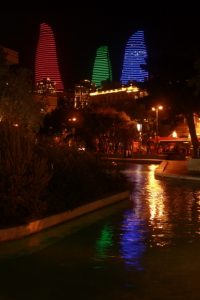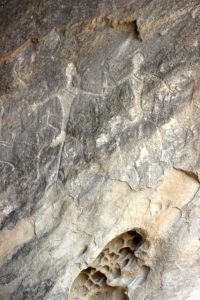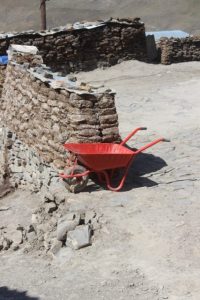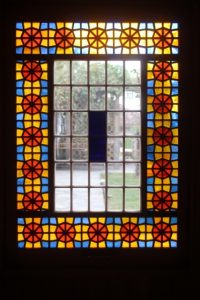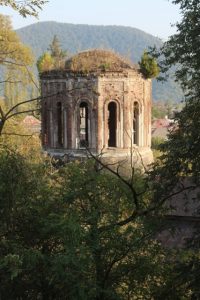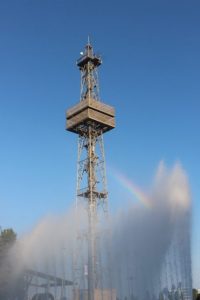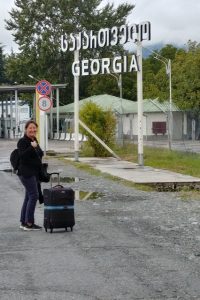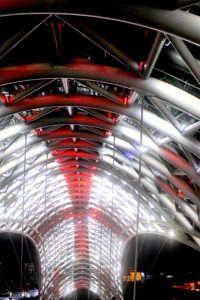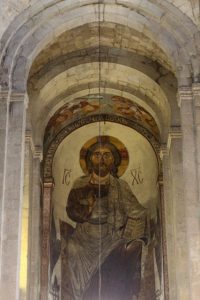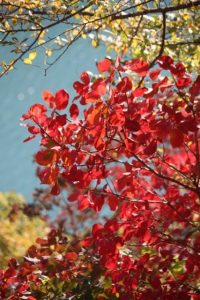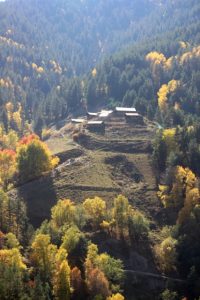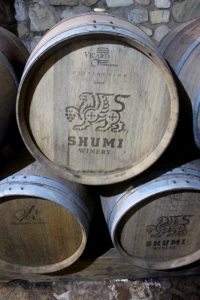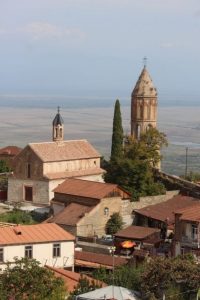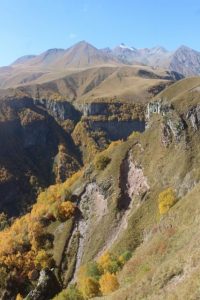 Having lived in Turkey and extensively traveled in Iran, the area in between begged to be explored, too. Which is what we did, initially, in the autumn of 2019, with a four week trip starting in Baku in Azerbaijan and finishing in Tiblisi, in Georgia, having covered just Azerbaijan and the east of Georgia. The intention is to return in 2020, for Armenia and the rest of Georgia. For the time being, below our travel experiences from the first part.
Having lived in Turkey and extensively traveled in Iran, the area in between begged to be explored, too. Which is what we did, initially, in the autumn of 2019, with a four week trip starting in Baku in Azerbaijan and finishing in Tiblisi, in Georgia, having covered just Azerbaijan and the east of Georgia. The intention is to return in 2020, for Armenia and the rest of Georgia. For the time being, below our travel experiences from the first part.
01. the Caucasus Plan: We are about to leave for our next trip, the first of two journeys into the South Caucasus. We start with Azerbaijan and Georgia, lots of variation and lots of things to discover. read more
02. the history: From Chistianity to Independence, in a 1000 words: much too short, of course, but here is a very quick overview of some of the history of the South Caucasus. No pictures, yet, I am afraid… read more
03. Baku: Azerbajian’s capital Baku is a fascinating modern city, with fabulous modern architecture, no doubt thanks to its oil wealth.
For modern Baku the only history that is visible is that of the last 20 years. And then especially of the spectacular, extravagant architecture that screams at you in every corner of the city. Forget Dubai, Baku is the place.
04. Old Baku: The small old centre of Baku, the Icarisahar, is an attractive, if somewhat complex, maze of streets and alleys, with some attractive but over-restored, monuments.
Not all of Baku is new, splendid modern architecture. The small heart of the city, called the Icarisahar, or Old Town, dates from at least as early as the 12th Century, when perhaps 7000 people lived inside its crenulated walls. I wonder if there are as many living here today; the Old Town is in fact one big hotel, spread over almost each and every well-restored – or newly built, but nicely fitting in – house. And what is not a hotel, is a restaurant or a carpet cum souvenir shop.
05. around Baku: There are lots of mildly attractive to somewhat disappointing attractions around Baku, but none so evocative as the oil fields.
Even Baku, city almost entirely surrounded by desert, has its attractions outside town. And the Baku tour operators have latched on to that, by designing a wide range of tours, all doing roughly the same. Including things we were not necessarily that interested in, and in any case, I hate tours. But renting a taxi for the day, in Baku, is not a good idea, either, because the drivers don’t always know their way to the sights, and cannot count on the support of local taxi drivers, who have nothing to gain by helping their, in their eyes, unfair competitors.
06. Quba and Xinaliq: Drab Quba, in the Northeast of the country, contrasts sharply with the mountain village of Xinaliq, amidst spectacular scenery.
The most beautiful scenery in Azerbaijan, or so they say, is east of Quba. And the prettiest village, Xinaliq, also happens to be east of Quba. Our next destination is a no-brainer. Especially because our proverbial luck struck again. The evening before we were to leave Baku I found the name of a man who can arrange day trips to the mountains, from Quba.
07. Nakhchivan, the capital: Nakhchivan, capital of the exclave of the same name, is a surreal city, mostly newly-built or restored, and that count for almost everything.
We were all set for playing a round of golf on Sunday morning, with our golf club director friend in Quba, when we abruptly changed our plans. Although not in the original itinerary, we decided to go to Nakhchivan, the Azeri exclave wedged in between Armenia and Iran. Armenia and Azerbaijan are at war with each other (and driving around via Iran involves a 20-hour bus ride and extra visas), so the only way of getting there is by plane from Baku. To still make it on the Sunday we needed to leave Quba relatively early.
08. Nakchivan, the country: Outside the capital, we visit a number of tourist attractions, varying from dilapidating to recently reconstructed, whilst enjoying the beautiful countryside.
Of course, there is more to Nakhchivan than only its capital. The Autonomous Region within the Republic of Azerbaijan has some 450,000 inhabitants, of which only 75,000 live in the city. So we arrange a car to explore more of it. Just a few of the more easily reachable sites, many others require four-wheel drive and lots of time, apparently.
09. Sheki: On the way to Georgia, we stop in Sheki, to admire some 18th Century palaces, as well as an old Albanian church in Kish.
Back in Baku, we take the night train to Sheki, our first stop on the way to the border with Georgia. A rather uneventful, not all that uncomfortable journey drops us at a little past 7 am at the Sheki station, which is some 20 kms away from the town. With one taxi driver left, our negotiation position is weak, to say the least, and we pay way over the odds to arrive at our hotel, an old caravanserai which has been renovated – commercially, not by Decree. We have been to many caravanserais in the past, but never slept in one, a nice experience.
10. Zaqatala: Close to the border, un-touristic Zaqatala has not too many sights to offer; but, it has the annual nuts festival!
On the way to Zaqatala, some 40 km from the Georgian border, and our last stop in Azerbaijan, we stop in Qax. Not for the town itself, which, according to our guidebook has older houses that ‘have been given a faux-antique look on a lane guarded by castle-style gateways and warrior statues’ – some other Decree of a Chairman, perhaps. No, we take a taxi to ‘charming little’ Ilisu, a small village up a beautiful high-altitude valley. Hmmm. In fact, most of Ilisu is heavily developed for tourism. Even the president has a house here, and it looks like many of the old-style buildings have made way for a series of holiday mansions for the rich and famous of Azerbaijan.
11. a look-back at Azerbaijan: There are few touristic highlights, yet, we stayed longer than planned in Azerbaijan, because with all its faults and contradictions it is a lovely country.
Before we left for the South Caucasus, quite a few people asked me what there was to see in Azerbaijan. Looking back, I have to admit: except for Baku, there is not much in terms of touristic highlights. Of course, the mountains beyond Quba, and those in the Ilisu area, are great for hiking in the summer, but there are other, better places in the world. Xinaliq village is charming, but many of the Iranian villages are equally charming, or more so. The Khan’s palace in Sheki is nice, but compared to some of the extravagant multi-storied houses and palaces in, again, Iran, it is actually very humble. Almost all of the historical buildings have been vastly over-restored, many have been rebuilt from scratch, without much authenticity left. And the number one tourist sight outside Baku, the petroglyphs in Qobustan, well, were also not the most convincing examples I have seen in the world.
12. into Georgia: Our first contact with Georgia is somewhat disappointing, but things are getting better.
Our first confrontation with Georgia is not good. Perhaps we were spoilt by the friendliness of the Azerbaijanis. Or perhaps, land border crossings are always a bit of a hit and miss. Entering the country was no problem, passport stamped, no interest in our luggage. No smile either, no ‘welcome to Georgia’ – where we had so many times a, smiling, ‘welcome to Azerbaijan’ in the past two weeks. Immediately across the border, two vultures descended upon us: taxi drivers. Again, as in Sheki, we were not in the strongest of negotiating positions, as they obviously worked together. But there was also a bus. Which was prepared to take us, for a far more reasonable amount of money, to the next village, Lagodekhi. Until the taxi vultures said something to the bus driver, who from then on refused us as passengers, and drove off half-empty.
13. Tbilisi: Georgia’s capital Tbilisi has much to offer, from modern architecture and attractive winebars to crumpling, but authentic apartment buidings and an Old Town full of wooden balconies.
Despite our rough start to Georgia, we came to appreciate its capital, Tbilisi. After the marathon had finished, Rustaveli Avenue quickly filled with traffic again, and with people on the pavement. Present-day Tbilisi was created by the Russians, who were called in as protectors by Georgian King Erkale II after a devastating Persian raid in 1795, which utterly destroyed the town. The Russians went to work with broad avenues and large squares, to make it a European-looking town, and made Rustaveli Avenue the axis.
14. a day in Tbilisi: Wandering through lesser-know Tbilisi we find a range of treasures, from a wonderful little museum to the massive old Soviet-style palatis.
To compensate for the travel guide-like entry on Tbilisi, let me take you on our last day in town. We had seen the main sights, didn’t have a fixed plan, just wanted to get out of the hotel – it was once more a brilliant day, bright sunshine, temperatures in the high 20’s, dry air. Instead of south-east, down Rustaveli Avenue once more, and maybe east, across the Mikvari River – the standard itinerary for Tbilisi -, we decided to make our way to the Georgian National Bank, all the way north, which apparently is housed in a beautifully constructed modern building
15. Mtskheta: In Georgia’s spiritual capital, Mtskheta, we get our first immersion in churches and cathedrals.
On the way to Kazbegi, a mountain village high up in the Caucasus, close to the Russian border, which we hope to reach tonight, we stop in Mtskheta – don’t worry about the impossible name, apparently it is pronounced ‘Skayta’. This is the old capital, and as many with argue, still the spiritual capital of Georgia. This, too, is where the Georgian royal family at the time, 337 AD, converted to Christianity; and this has been the seat of the Georgian Orthodox Church until the 12th Century, the days of Georgian expansion from the Black Sea to the Caspian, started by King Davit de Builder and completed by his great-grand daughter, Queen Tamar – only to be brought down by the Mongol raids of Genghis Khan in 1220. This is Kartli, now just a province of Georgia, but long one of the dominant principalities.
16. the winery: We get our first introduction in Georgian wine, a somewhat mixed experience, but made good by some excellent wines.
Not entirely coincidentally, our interest in Georgia – the reason we are here – was at least in part linked to Georgia’s reputation as a wine producing country. Archaeological evidence points to the first wine making here no less than 8000 years ago, which has opportunistic entrepreneurs claiming Georgia as the land of 8000 vintages. Right! Between Muslim invaders, Genghis Khan, Tamerlane and phylloxera I am sure a couple of years have been skipped, and during the Soviet years quantity was preferred over quality, but today’s Georgian wine is generally accepted as excellent. And that has to be sampled.
17. the Georgian Military Highway: One of the most accessible roads into the Caucasus is the Georgian Military Highway, which continues into Russia, with several touristic attractions along the way, both man-made and natural.
The Georgian Military Highway – what’s in a name? – has been a trading artery since antiquity, allowing goods to be transported between Georgia and Russia across the Caucasus. It connects Tbilisi with the nearest Russian town of importance, Vladikavkaz. The military component in the name is mostly derived from Russian troops, who used the road for the first time at the end of the 18th Century, when Russia began to covet its Transcaucasian neighbours. It was also the Russian army who transformed the mountain track into a proper road in the 19th Century, at a for that time staggering financial expense.
18. Tusheti: To get to one of the most remote areas of Georgia, Tusheti, we undertake a gruelling drive, and back, but the spectacular mountain scenery in autumn is worth every minute of it.
Several parts of northern Georgia are located north of the Caucasus watershed. Thanks to the Georgian Military Highway the Kazbegi area, around the north-flowing Tegri River, is perhaps the most accessible of those valleys. Tusheti is the remotest, by far. Bordering unruly Chechnya and Dagastan, in Russia, this long forgotten region has been self-sufficient for centuries, growing their own food, and enough of it to survive the long winters. Which, apparently, gave them the idea to declare independence from the Soviet Union in the 1940s; big mistake, of course, in between fighting the Germans the Red Army found time to crush this uprising and send the men to the Gulag, the women and children elsewhere. Yet, it was not until 1982 that the first, and so far only road into the area opened, and connected Tusheti with the outside world.
19. Telavi: Telavi itself is not of much interest, but the town is surrounded by some fabulous churches and cathedrals, many supporting the remains of vivid frescos.
The small town of Telavi is the capital of the province Kakheti, the most important wine-producing region of Georgia. So it is no coincidence that we have set up our base here for a few days. The centre is dominated by the Batonistsikhe citadel, a crenulated fortification that contains the art museum and the old palace of King Erkele II. The palace seems to be closed indefinitely; the museum is only closed today, probably because someone important is on its way, because the place is teeming with police. A brief walk through the rest of town does not yield anything else of interest – except for the many wine making and wine tasting and wine selling facilities, of course. But not in the morning.
20. Telavi (2): The real reason to spend time in Telavi is, of course, to sample the wines of Georgia’s most famous wine region. Which we did at the Shumi winery.
Of course, we cannot spend time in Telavi, Georgia’s wine capital, without taking the stuff a little more seriously than we have done so far. If only because in our hotel there is a wine production facility in the basement, which generates a dominant stench in the corridors, 24 hours per day – especially in the mornings rather disturbing, actually.
21. Sighnaghi and Udabno: The last days of our journey we visit the touristic centres of Sighnaghi and Davit Gareja, both disappointing for different reasons, and we travel back via the Rustavi rustbelt of delapidated old Soviet industries.
From our Shumi wine tasting experience we move on to what is billed as Kakheti’s prettiest village, Sighnaghi. We approach via one of the minor roads, and enter through one of the many gates in the 4.5 km long wall that was built around the place in 1772, and is still remarkably good condition – or perhaps has been restored remarkably well, looking authentic. Which is a bit the story of Sighnaghi: it looks fairly authentic, with its cobbled streets and its large wooden balconies – which definitely have been restored -, its piazza and its museums. And somehow that alone proves to be an enormous attraction; there is really very little else to do, except strolling around, yet this is an extremely popular village. Sighnaghi is the classic tourist trap.
22. Georgia so far: Some early verdict about Georgia so far, where we intend to return within a year.
We were never going to cover the whole of Georgia, on this trip. And because we spent more time in Azerbaijan than planned, we only managed the smaller eastern part of the country, and some of the valleys immediately to the north of the capital. No Black Sea coast, no Svaneti Valley, not even the Stalin Museum in Gori.
Back next year, for the rest?

